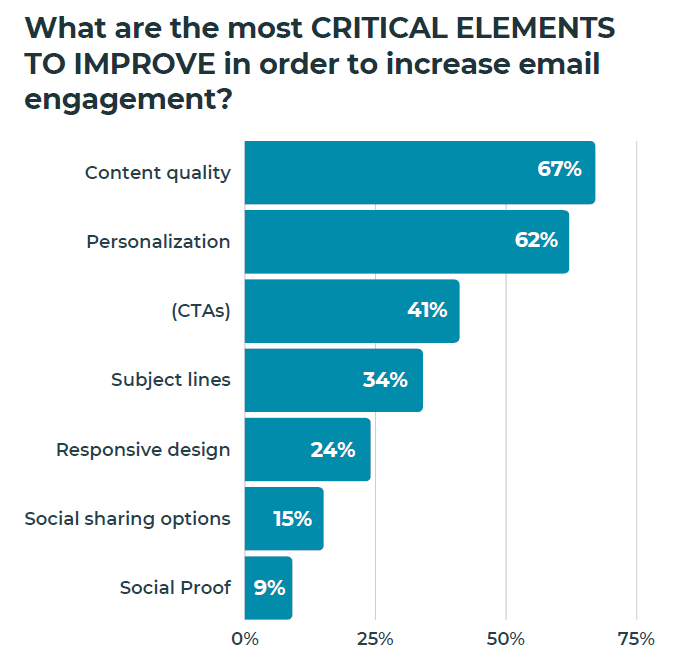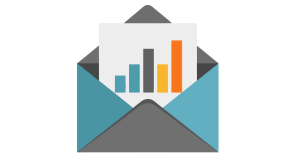Email marketing doesn’t just play around with the concept of demographics employed by most acquisition marketing channels. There’s an actual, identifiable human behind every email address and they deserve better than a “catch-all” email communication.
In many ways, email is a marketer’s dream. It’s not only a medium where individual consumers opt in and subscribe to your campaigns, suggesting they really value your email communications. It’s also a place where your subscribers surrender so much personal information over the lifetime of their relationship with an organization that it really would be remiss not to tailor your campaigns to suit their individual needs.
Why is Email Personalization So Important?
Successful email marketers understand that increasing email personalization is critical to improving campaign engagement. This statement is supported by 62% of email marketing professionals surveyed for the recent State of Email Marketing from the B2B Perspective report, published by emfluence in partnership with Ascend2.

When you consider that 56% of those same marketers surveyed said that increasing engagement was their greatest challenge, the value of email personalization becomes much more apparent.
Personalization Creates a Commercial Advantage in a Crowded Environment
When you personalize your email marketing campaigns, you are letting your subscribers know just how much they mean to you. This is important because the inbox environment is so noisy. If you want to stand out in a wall of competitive commercial messages and, let’s not forget, highly personal communications from friends, colleagues, and family — you better make an effort to position your campaigns from a known and trustworthy connection.
Consider this: Take a quick look at your inbox. Do you instantly recognize where every email came from? Do you ever engage with these emails positively? This is precisely why you need to personalize your campaign strategy.
Get Busy Targeting Busy People
The average American office professional deals with 15 emails every hour of the working day. A significant percentage of these emails are simply ignored. When you personalize your emails, you demand attention by highlighting that your message is relevant, timely, and engaging. Why risk your hard-won relationships by sending generic campaigns which may or may not be of any interest to your subscribers?
When you’ve captured your subscribers’ attention, you can talk about anything with a real degree of confidence.
Personalization can be used to highlight details about:
- Your product or service: When you know your subscriber’s specific interests, you can be sure that the products or services you are promoting are entirely relevant to their needs, dramatically improving the chances of a sales inquiry or purchase.
- Geographic location: It makes perfect business sense in a global economy to provide a local service for local customers. Geographic personalization might mean pricing your products or services in local currencies, highlighting international shipping rates, and sending your emails at a time optimized for the local market.
- Behavior: Every subscriber follows their own path when engaging with your campaigns. Some will engage with you because they are on a journey of discovery. Others will be ready to make a purchase. It’s essential that you give them all the tools they need to continue on the right journey. Targeted re-engagement campaigns and cart abandonment emails are powerful examples of personalized emails based on behavior.
For marketers looking to take email personalization to the next level, marketing automation technology can help to deliver the right message to the right person at the right time.
Where Does the Journey to Email Marketing Personalization Begin?
Suppose you compare email marketing personalization to a conversation with your subscriber. In that case, the journey to better email marketing personalization starts the very moment you say “Hello,” and continues with every supplementary engagement.
In email marketing, these engagements can occur in many different places. However, the most obvious starting points include:
- Subscription forms: The beginning of your email marketing relationship. Don’t ask too many questions or you risk stifling the conversation before it even begins. Instead, collect your subscribers’ names and email addresses, and the rest will follow.
- Email analytics: This is the place where you really begin to listen to your subscribers. Your email analytics will tell you precisely what they are interested in and where your email campaigns direct them on their journey. Take the opportunity to monitor your email engagement carefully and use the information to segment your lists accordingly.
- Wider integration with your Martech stack: The conversation you started in the email inbox is often expanded across your wider Martech stack. When you consider how much information can be acquired from your eCommerce platform or CRM system, you’ll want to ensure all your technology platforms are broken out of their marketing silos.
So What Elements of Your Email Campaigns Should Be Personalized?
- Your subscriber’s first name: Addressing your subscriber by their first name should be considered a vital first step on the route to building trust. If your subscriber has given you their name, it’s only polite that you use it. It’s also a great idea to sign off any emails using a recognizable name.
- Subject lines: Your subject line is your first line of defense between engagement and being ignored, deleted, or marked as spam. Remember, the moment your subscribers start ignoring your emails is the first step on a journey to irrelevance, where it becomes easier to ignore each of your sends. Therefore, if you want any further positive engagement, ensure your subject lines are 100% relevant to your individual subscribers.
- Body content: This is the place where you continue the conversation you started in the subject line. If you want your email engagement to go beyond an open, your offer has to hit the mark, or it will be dismissed as irrelevant. Simple list segmentation is a great place to start personalizing your body content based on subscribers’ personal information and previous engagements. However, for a more sophisticated approach, consider employing a strategy of dynamic content based on your subscribers’ geographic locations, demographics, or previous purchases.
How can you start personalizing your email campaigns? Check out our infographic and then contact us at expert@emfluence.com.

